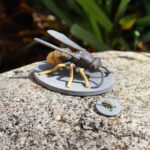José Francisco Arteaga Alarcón has developed 3D printed beehives to support sustainable farming. Alarcón, a student at Chapingo Autonomous University, Mexico, used resin 3D printing to create the hexagonal structures, eliminating the bees’ need to construct hives themselves. This approach allows bees to focus on honey production and plant pollination.

Traditional hive construction relies on beeswax and natural secretions, which are time-consuming to produce. While beekeepers use hive boxes to enhance honey production, the global decline in bee populations necessitates better support methods. 3D printed hives present an alternative by pre-forming the hexagonal structures, thus reducing bee labor and mitigating fatigue, heat, noise, and space issues common in conventional hives.
The hives include pre-existing panels, enabling bees to prioritize honey production. The honey harvest is intended to be automated directly in the honeycomb. These hives offer numerous benefits, including a reduction in stress and improved growth conditions for bees.
Chapingo Autonomous University, affiliated with Mexico’s Ministry of Agriculture and Rural Development, may receive government funding for ongoing research. Mexico’s rich bee biodiversity supports an annual production of over 60,000 tons of honey, benefitting more than 43,000 beekeepers.
Source: parametric-architecture.com










